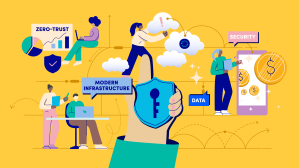- Sponsored
- Insights
Rewiring government: Industry AI journeys as blueprints for public sector change

The pressure to make the federal government more efficient continues to grow. Artificial intelligence (AI) is part of a technology-driven solution, but navigating its practical implementation can seem daunting. Given the obstacles agency leaders face, from budget scarcity, entrenched legacy systems, data silos, and workforce preparedness, the sheer complexity of change management can be challenging.

Today’s federal leaders understand the importance of adopting AI but face real challenges in aligning that goal with the complex, often slow-moving operational changes required across their agencies. IBM’s own story of AI-driven digital transformation can serve as a blueprint and provide helpful insights for federal agencies in the middle of their own digital transformations. As “Client Zero,” we are using our own technologies, including generative AI, and those of our partners to eliminate complexity, simplify workflows and automate manual tasks to drive productivity and fuel growth.
Two years ago, IBM set an audacious goal: save $2 billion in 24 months by applying our own AI technologies to our internal operations. We didn’t just meet that goal; we surpassed it, achieving $3.5 billion in savings to date. This wasn’t accidental; it resulted from a structured approach focused on three core pillars: cost efficiency, workforce efficiency, and operational efficiency. This framework offers a replicable model for the public sector.
Our journey began with cost efficiency, specifically targeting IT expenditures. By applying our Technology Business Management and AI-driven FinOps suites to our $2.5 billion IT budget, we focused on ways to reduce our cloud spending and better use our IT personnel costs.
The results were immediate and significant. We realized 30% infrastructure cost savings, translating to $600 million in enterprise cost takeout, including $50 million in cloud savings right at the outset, and $170 million in software license cost reduction. The effort demonstrated the power of AI in providing holistic visibility and enabling data-driven decisions for rapid ROI in complex IT environments – a challenge familiar to many federal agencies.
That effort spun a flywheel in motion. Next, we focused on delivering a digital-first employee experience by building and deploying domain-specific generative AI digital assistants. Our AskIT assistant, for example, is trained on 80% of the IT issues the company faces most frequently and covers more than 200 common IT support topics. Using AI and natural language processing, AskIT has allowed our IT support staff to shift their focus to providing high-touch support, handling more complex and critical issues. And our AskHR assistant, for instance, is delivering a new simplified, personalized and data-driven employee self-service experience by leveraging the power of IBM AI and automation. Since its rollout, 94% of IBM’s company-wide lower-level HR queries were answered by our AskHR assistant, freeing up HR professionals to focus on more complex issues. Imagine replicating this across multiple functions inside federal agencies, freeing up personnel from routine tasks to focus on higher-value, mission-critical activities.
We also addressed operational efficiency by streamlining our business and finance-focused processes. In finance, we used AI and automation to reimagine our complex pricing approval process, which handles over 100,000 requests annually. Automating up to 50% of manual tasks, 15% of our finance-related tasks are fully automated approvals, cutting cycle times by 75%, and saving over 35,000 manual labor hours.
IBM as “Client Zero” proves that substantial efficiency can be gained at scale using AI. Our experience, enhanced productivity, and improved employee experience are not abstract possibilities but documented outcomes obtained from a thoughtful AI-driven strategy.
By systematically applying AI to optimize costs, empower employees, and streamline operations, agencies can unlock significant savings, improve service delivery, and ultimately, better execute their missions for the American people. The path has been tested; the results are compelling. It’s time to embrace this proven model for a more efficient government.
Learn more about how IBM can help your agency leverage AI to improve organizational and operational efficiency.






